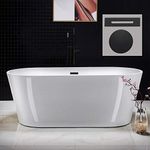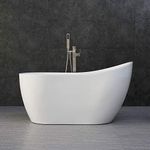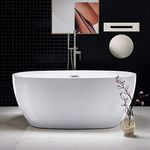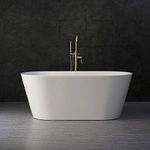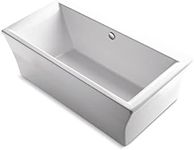Buying Guide for the Best Freestanding Bathtubs
Choosing the right freestanding bathtub can significantly enhance your bathroom's aesthetic and functionality. When selecting a freestanding bathtub, it's essential to consider various factors to ensure it meets your needs and preferences. Here are some key specifications to help you make an informed decision.MaterialThe material of a freestanding bathtub affects its durability, weight, and heat retention. Common materials include acrylic, cast iron, and stone resin. Acrylic is lightweight and retains heat well, making it a popular choice for many. Cast iron is extremely durable and retains heat for longer periods, but it is very heavy and may require reinforced flooring. Stone resin offers a luxurious look and excellent heat retention but can be quite expensive. Choose a material that aligns with your preferences for maintenance, durability, and aesthetic appeal.
SizeThe size of the bathtub is crucial for both comfort and fitting into your bathroom space. Bathtubs come in various lengths, widths, and depths. A standard length is around 60 inches, but you can find tubs ranging from 55 to 72 inches or more. The width typically ranges from 27 to 32 inches, and the depth can vary from 14 to 20 inches. Consider the available space in your bathroom and your personal comfort preferences when selecting the size. Ensure there is enough room for installation and movement around the tub.
ShapeFreestanding bathtubs come in various shapes, including oval, rectangular, and slipper. The shape affects both the aesthetic and the comfort of the tub. Oval tubs are classic and provide a comfortable soaking experience. Rectangular tubs offer a modern look and can fit well in contemporary bathrooms. Slipper tubs have a higher backrest on one side, providing extra support and comfort for lounging. Choose a shape that complements your bathroom design and meets your comfort needs.
CapacityThe water capacity of a bathtub determines how much water it can hold, which affects the soaking experience. A typical freestanding bathtub can hold between 40 to 80 gallons of water. If you prefer deep soaking, look for a tub with a higher capacity. However, keep in mind that higher capacity tubs will require more water and may take longer to fill. Consider your water usage preferences and the capacity of your water heater when selecting a bathtub.
WeightThe weight of a freestanding bathtub is an important consideration, especially if you are installing it on an upper floor. Heavier materials like cast iron and stone resin can weigh several hundred pounds, while acrylic tubs are much lighter. Ensure that your bathroom floor can support the weight of the tub when filled with water. If you are unsure, consult a professional to assess the structural integrity of your flooring.
InstallationFreestanding bathtubs can be installed in various ways, including floor-mounted, wall-mounted, or with a freestanding faucet. The installation method affects the overall look and functionality of the tub. Floor-mounted installations offer a clean and minimalist look, while wall-mounted options can save space. Freestanding faucets provide flexibility in placement but may require additional plumbing work. Consider the layout of your bathroom and your preferred style when choosing the installation method.
StyleThe style of a freestanding bathtub can range from traditional to modern, and it significantly impacts the overall aesthetic of your bathroom. Traditional styles often feature clawfoot designs and ornate details, while modern styles are sleek and minimalist. Choose a style that complements your bathroom decor and reflects your personal taste. Consider the overall theme of your bathroom and how the bathtub will fit into that design.
